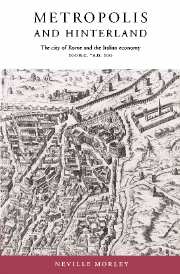Book contents
- Frontmatter
- Contents
- List of maps and figures
- Preface
- List of abbreviations
- Introduction: Rome and Italy
- 1 The metropolitan city in a pre-industrial economy
- 2 The demographic burden
- 3 A model of agricultural change
- 4 The transformation of the Roman suburbium
- 5 Agricultural development in central Italy
- 6 Exploiting the margins
- 7 Marketing and urbanisation
- Conclusion
- Bibliography
- Index
4 - The transformation of the Roman suburbium
Published online by Cambridge University Press: 17 August 2009
- Frontmatter
- Contents
- List of maps and figures
- Preface
- List of abbreviations
- Introduction: Rome and Italy
- 1 The metropolitan city in a pre-industrial economy
- 2 The demographic burden
- 3 A model of agricultural change
- 4 The transformation of the Roman suburbium
- 5 Agricultural development in central Italy
- 6 Exploiting the margins
- 7 Marketing and urbanisation
- Conclusion
- Bibliography
- Index
Summary
It is within the immediate hinterland of the city, the region with the best access to the urban market, that we may expect to find the most significant and visible changes in agricultural practice; a greater degree of orientation towards the market, with specialisation in a particular set of crops and more intensive cultivation. An examination of the history of this region is therefore the obvious starting point for this study.
The definition of this ‘immediate hinterland’ is inevitably somewhat arbitrary, and depends above all on the particular questions that are being considered. It could be defined as the area characterised by a particular set of activities – the intensive horticulture which von Thünen's model predicts for land close to the urban centre – so that its expansion or contraction over time can be charted. Alternatively, a region could be defined on the basis of territorial homogeneity. The advantages of this latter approach are that it emphasises the variety of activities that may take place within the same geographical area, interacting and competing for resources. Production is not considered in isolation from consumption or from social and demographic change.
The Roman lowlands, bounded by the Monti Sabatini, Sabini and Tiburtini, the Colli Albani and the sea, can conveniently be considered as a territorial unit (Map 2). Most of this area lies within 30 km of Rome, extending a little further up the valley of the Tiber; it can fairly be described as the immediate hinterland of the city.
- Type
- Chapter
- Information
- Metropolis and HinterlandThe City of Rome and the Italian Economy, 200 BC–AD 200, pp. 83 - 107Publisher: Cambridge University PressPrint publication year: 1996

